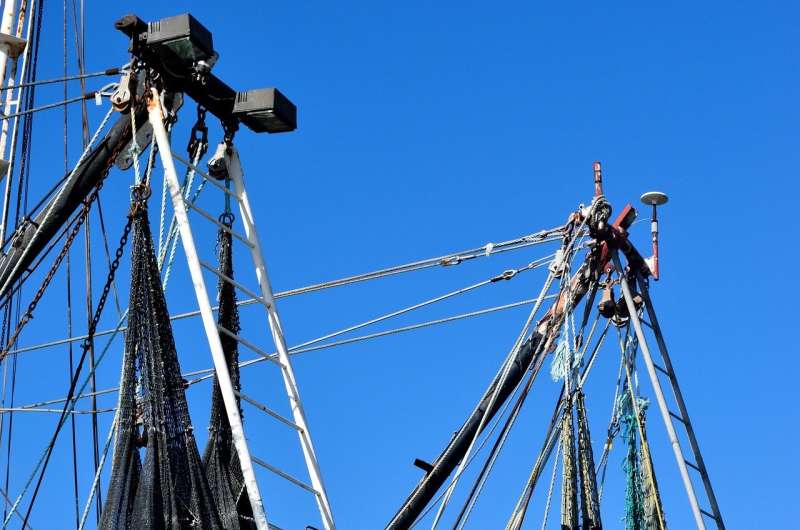
Credit: Pixabay/CC0 Public Domain
An interdisciplinary team of experts from the University of Huelva, the University of Miguel Hernández and the Spanish Institute of Oceanography (IEO) has designed an innovative and integrated fishing activity monitoring system based on the use of sensors typically installed in a smartphone to detect in real time and, according to the movement of the vessel, what type of fishing activity which is done on board the ship. This information is relevant to the fishing sector to estimate the amount of fish in a particular area of the sea and to calculate the catch.
The novelty of this low-cost application lies in the ease of installation in any mobile device and the speed of data transfer in real time, in less than a second. In addition, as stated in the study entitled “Is the vessel fishing? Distinguishing the fishing activity with smart, low-cost mobile devices through traditional and exploratory methods” published in the journal Expert systems with applicationsThis tool allows you to locate a ship with great accuracy, regardless of its size, and the amount of time you spend fishing.
This mobile application, called FAMIS, provides real-time information on the ship’s working stage. In this respect, the time spent by the vessel in fishing is a determining factor for evaluating the fishing effort, i.e. to calculate the amount of catch in a particular area and the amount of fish that may be present at that place at that particular time.
Current systems for monitoring fishing vessels indicate the position of the boats over a longer period of time (about every three minutes), require prior installation on deck, and are controlled by relevant fishing authorities.
These are tracking systems similar to the Global Positioning System (GPS) that send a signal to the Earth. “This tool allows us to know the position of the boat, but while it is at sea, we do not know how much time it spent casting nets, fishing and collecting all the materials. The FAMIS application goes further and makes it possible to recognize through the movement of the vessel the fishing maneuver that you are doing them at all times,” Juan Carlos Gutierrez Estrada, a researcher at the University of Huelva and one of the authors of this study, told the Discovery Foundation.
Experts in computer science, biology and oceanography have implemented this system because both smartphones and tablets carry integrated sensors that allow the ship’s motion to be determined from the data they record. “Depending on the type of maneuvering (whether the boat is accelerating, rolling, etc.), the ship has a distinct motion that is reflected in the accelerometer. It also allows us to know if the ship is throwing its net or recovering its gear,” says Gutierrez. Estrada.
Artificial intelligence on board
This system, which sends information as soon as a mobile phone is placed on the boat’s deck, has been tested using various statistical methods and artificial intelligence models based on artificial neural networks and support vector machines. The application digitally and officially displays on its screen all the information captured by the various sensors: GPS, accelerometer, gyroscope and magnetic field. The most efficient model will be integrated into the application and will provide information about the activity performed by the boat in real time.
To prove the usefulness of these sensors, tests were carried out from the oceanographic ship Miguel Oliver on one of its voyages. This ship with a length of 70 meters and a width of 12 meters is equipped with technological equipment for navigation, fishing and oceanographic research. “This boat allows for the possibility of recording four to six net transfers per day, and to acquire the data under very adverse conditions, due to the large displacement and light weight characteristics of the fishing gear used in the sampling,” says the co-author of this study. .
According to experts, the model can be used with any type of ship, as it can be calibrated and adapted for use in small boats. “The main advantage of this application for the fishing industry is its ability to calculate fishing effort, which is an essential criterion for estimating the relative abundance of fish at sea,” says Gutiérrez Estrada.
Owner says rogue waves hit Hawaiian fishing boat that sank
MM Galotto-Tébar et al, Is the ship fishing? Distinguishing the fishing activity using low-cost smart mobile devices through traditional and guided methods, Expert systems with applications (2022). DOI: 10.1016 / j.eswa.2022.117091
Provided by Fundación Descubre
the quote: Design of a mobile app that identifies in real time the activity of fishing vessels (2022, September 23) Retrieved on September 24, 2022 from https://techxplore.com/news/2022-09-mobile-app-real-fishing-vessels. programming language
This document is subject to copyright. Notwithstanding any fair dealing for the purpose of private study or research, no part may be reproduced without written permission. The content is provided for informational purposes only.

